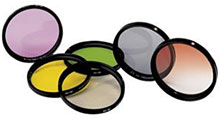Photographic
filters are among the most essential equipment in a photographer's
bag.
With the use of filters alone you can make your photographs look
more different and interesting. It is obvious that digital photography,
along with the rich in filters image editing programs, have made
most of the conventional filters useless, thus we will refer
to filers that can be useful in the modern digital era photography,
as well as in classic black & white and color films.
Photographic filters exist in different forms and shapes.
The two most dominant categories are
a) The autonomous round crystal filters with a metal frame
screwing in the front end of the lens, and their diameter
should match
that of the lens. These may vary from 38mm to 77mm, with
most common those of the 49mm and the 52mm,
b) The square plastic or crystal filters that you put on
a carrier already adjusted on the lens. Well known filters
of
this category
are the ones from KODAK and the filter system of COKIN.
Filters, as an added optical element on a very well designed
combination of optical elements that the lens is, it is mandatory
that they should well designed, with multi coated layers
and from fine optical crystals, otherwise they cut down from
the
quality of the lens.
The most qualitative filters are those of German W+B (but
they are very expensive) and the Japanese HOYA that come
in more
reasonable prices. A cheaper but reliable solution is the
filters of MARUMI.

TYPES OF FILTERS
Lens- protective Filters
UV
The common filter for this use is a UV filter that does not produce
any chromatic alteration. However it protects the lens from dust,
scratches and falls. It has another usefulness; it cuts the not
needed ultraviolet radiation that the photographic materials
are also sensitive to.
But this is achieved by any crystal and specifically by the crystals
of the modern lenses with the multiple coatings. The same anti-UV
protection have also all the kinds of digital sensors.
1A
Another filter that is used for the same reasons with the UV
is the skylight filter or 1A that however is not completely
neutral but it has a lightly pink nuance. In the black & white
it does not have any effect, but in colour it cuts a little
of the blue radiation, and for this it is usually used in big
altitudes and in clouded over rainy days where the blue radiation
is in excess. Of course for a better correction in such situations
other more suitable filters exist, like the 81A or the 81c.
ND. Filters of neutral density.
The filters of neutral density are filters graded in grey
tones and they make only thing; they cut the light that will
pass via
the lens in the camera. They usually exist in densities with
differences of one stop, and the 2 cuts 1 stop the 4 cuts 2
etc. Or graded with their real density (D) value (ex. 0.3,
0.6 etc).
The filters of neutral density are useful in situations that
we need openly diaphragms and we have a lot of light (ex. when
we want small depth of field) or when we need slow speeds (ex.
Panning technique). There are also the degrade filters of neutral
density that are useful when we have two departments of picture
with big lightning differences.
Polarising filters.
They are the most expensive usually filters but also the filters
that no program of picture editing cannot make what they offer.
The polarising filter is constituted by two crystals of which
one is able to turn, thus we can select the result that it
will have in our picture. Its basic applications are the control
of reflections and the saturation of colours and it exists
in two types, linear polarizer και circular. The second is
essential in autofocus cameras.
Close
up Filters.
The close up filters are the cheap solution when we want to photograph
from very near, because they increase the magnifying faculty
of our lens and substitute the macro lenses. It is unnecessary
to say that their quality is low. They are graded in degrees
of enlargement (+1, +2 +3, etc) and they are usually sold in
sets of 3 or 4. Along with the rings of lens inversion, the
extension tubes and Bellows , they are the elements that try
to cheaply substitute a macro-lens (that usually has quality
insuperable).
Filters
of chromatic correction for the black & white photograph.
These filters are colourful and they help us in the control of
tone of grey that will be attributed to the various colours
in our photographs. Certain examples: an orange filter will
attribute the sky as darker grey from that which it would record
the film- as a result the clouds will distinguish in the picture,
and a red filter would record the sky almost black and all
red objects in our photographs much brighter from what they
really are.
It may appear that the image-editing programs have made the photographic
filters pass in disuse, but most of the times the result with
the filters is better than any treatment, even with digital
cameras , not to mention that nothing cannot replace a polarizer
or neutral density filter.
PHOTOGRAPHY
FILTERS



